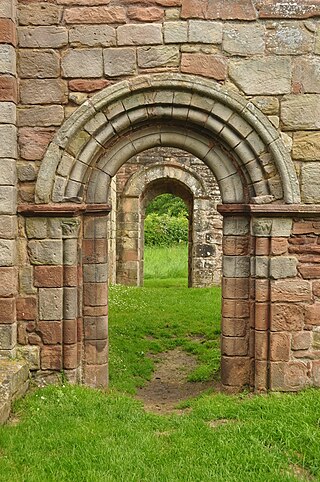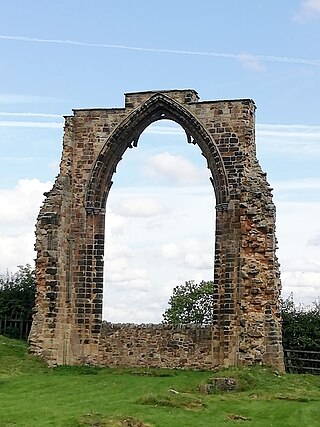
White Ladies Priory, once the Priory of St Leonard at Brewood, was an English priory of Augustinian canonesses, now in ruins, in Shropshire, in the parish of Boscobel, some eight miles (13 km) northwest of Wolverhampton, near Junction 3 of the M54 motorway. Dissolved in 1536, it became famous for its role in the escape of Charles II of England after the Battle of Worcester in 1651. The name 'White Ladies' refers to the canonesses who lived there and who wore white religious habits.

Breadsall Priory is a former Augustinian priory in Derbyshire, situated around two kilometres north of Breadsall, and two kilometres east of Little Eaton. The priory was established before 1266 by a member of the Curzon family. Only a small priory, Breadsall was dissolved in 1536.
Southwick Priory or Our Lady at Southwick was a priory of Augustinian canons founded in Portchester Castle on Portsmouth Harbour and later transferred 2 miles (3.2 km) north to Southwick, Hampshire, England. It ceased at the Dissolution of the Monasteries in 1538.

St. Botolph's Priory was a medieval house of Augustinian canons in Colchester, Essex, founded c. 1093. The priory had the distinction of being the first and leading Augustinian convent in England until its dissolution in 1536.

Mattersey Priory is a former monastery of the Gilbertine Order, located near the village of Mattersey, Nottinghamshire, England. It is managed by English Heritage.

Church Gresley is a large suburban village and former civil parish in the South Derbyshire district of Derbyshire, England. The village is situated between Castle Gresley and the town of Swadlincote, with which it is contiguous. By the time of the 2011 Census the village was a ward of Swadlincote, of which it is now effectively a suburb, and the population of Church Gresley ward was 6,881. The village forms part of the border with Leicestershire to the southeast. Nearby villages include Albert Village, Linton and Overseal.

Newark Priory is a ruined priory on an island surrounded by the River Wey and its former leat near the boundary of the village of Ripley and Pyrford in Surrey, England.

The Priory Church of St Peter, Thurgarton is a former house of Canons Regular or "Black Canons" and now a Church of England church in Thurgarton, Nottinghamshire, England.
Poughley Priory was a priory of Austin Canons at Chaddleworth in the English county of Berkshire, located between Great Shefford and Leckhampstead.

Bradbourne Priory was a priory in Bradbourne, Derbyshire, England.
Repton Priory was a priory in Repton, Derbyshire, England. It was established in the 12th century and was originally under the control of Calke Priory. It was dissolved in 1538.

Leonard Stanley Priory was a priory in Gloucestershire, England. Over the years following the dissolution most of the buildings of the priory complex have been destroyed.

Tonbridge Priory was a priory in Tonbridge, Kent, England that was established in 1124. It was destroyed by fire in 1337 and then rebuilt. The priory was disestablished in 1523. The building stood in 1735, but was a ruin by 1780. The remains of the priory were demolished in 1842 when the South Eastern Railway built the railway through Tonbridge, the original Tonbridge station standing on its site.
Alvingham Priory was a Gilbertine priory in St. Mary, Alvingham, Lincolnshire, England. The Priory, established between 1148 and 1154, was a "double house", where religious of both sexes lived in two separate monasteries. They did not commonly communicate with one another, and there was an internal wall dividing their priory church. The superior of every Gilbertine house was the prioress, the prior being really an official of her house.

Sempringham Priory was a priory in Lincolnshire, England, located in the medieval hamlet of Sempringham, to the northwest of Pointon. Today, all that remains of the priory is a marking on the ground where the walls stood and a square, which are identifiable only in aerial photos of the vicinity. However, the parish church of St Andrew's, built around 1100 AD, is witness to the priory standing alone in a field away from the main road.
Priory of St. Thomas near Stafford was an Augustinian religious house near Stafford, Staffordshire, England. Founded sometime in approximately 1174, it was a surrendered to the Crown in 1538, during the Dissolution of the Monasteries.

Maxstoke Priory was an Augustinian priory in Warwickshire, England. The substantial remains are on Historic England's Heritage at Risk Register due to their poor condition.
Longleat Priory was a priory near Warminster, Wiltshire, in the south of England. A short-lived priory was established and dissolved near to Longleat in the 12th century. The main priory was established before 1233 and was under the control of the Dean of Salisbury until its dissolution in 1529.

Dale Abbey, also known as the Abbey of Stanley Park, was a religious house, close to Ilkeston in Derbyshire. Its ruins are located at the village of Dale Abbey, which is named after it. Its foundation legend portrays it as developing from a hermitage, probably in the early 12th century.
Elizabeth Lorde was an English prioress of Wilberfoss. During the Dissolution of the Monasteries she surrendered Wilberfoss Priory as required by law and accepted a pension.

















